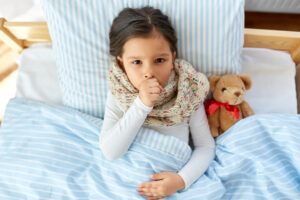My child has croup. Now what?
Human parainfluenza viruses (HPIV) commonly cause upper and lower respiratory illnesses in infants, young children, older adults, and people with weakened immune systems. However, infection occurs most frequently among children 6 months to 3 years. HPIV-1 and HPIV-2 both cause croup, with HPIV-1 most often identified as the cause in children. Both viruses can also cause upper and lower respiratory illness and cold-like symptoms.
What are the Symptoms of Croup?
Croup (acute laryngotracheobronchitis) is characterized by “acute laryngeal and subglottic swelling, resulting in hoarseness, cough, respiratory distress, and inspiratory stridor,” according to the AAP. Other symptoms of human parainfluenza virus 1 include:
- sore throat
- sneezing
- wheezing
- ear pain
- irritability
- decreased appetite
Symptoms usually resolve within 48 hours, but severe infection can, rarely, lead to pneumonia, and to respiratory failure and arrest.
How Do You Get Croup?
Croup is typically caused by a virus spread through respiratory droplets or direct contact with an infected individual. It is contagious from the onset of symptoms until they resolve. Croup usually has an incubation period of 2 to 6 days.
How Can I Prevent My Child From Catching Croup?
You may be able to reduce your risk of HPIV and other respiratory viral infections by
- washing your hands often with soap and water for at least 20 seconds
- avoiding touching your eyes, nose, or mouth
- avoiding close contact with people who are sick
What Are Some Common Treatments for Croup?
ANTIBIOTICS
Most cases of croup are caused by a virus, which means that antibiotics are not only ineffective, but potentially dangerous. Rare cases are caused by bacteria, but this can only be confirmed through laboratory testing.
HONEY
A recent study gave honey preparations infused with eucalyptus and citrus oils to children before bedtime. Compared with placebo, the preparation was found to reduce the frequency and severity of cough while also improving sleep quality.
Honey, both plain and infused with essential oils, has been found to reduce symptoms of respiratory infections like croup. Honey cannot be administered to children under 12 months, but it is an effective addition to a routine for older toddlers with croup.
EUCALYPTUS OIL
Eucalyptus essential oil has been used to treat upper respiratory infections in children for over 100 years. It is a core ingredient in Vicks Vapor Rub, and helps to promote clear breathing. In a 2010 study, a vapor rub was compared to placebo
to establish efficacy and safety for nighttime coughing. Eucalyptus was found to reduce cough severity, congestion, and sleep difficulty for both children and parents. Eucalyptus oil should only be used on children 2 years or older. Side effects included cooling and burning sensations to the skin. For young children, E radiata and E smithii are preferred.
COMFORT MEASURES
Traditionally, croup has been addressed through exposure to hot steam and fresh, cold air. These environmental factors still provide comfort and help to promote clear breathing.
REFERENCES
Cetinkaya F & Turgut S. (2001). The relation between recurrent acute subglottic laryngitis and asthma in children. International Journal of Pediatric Otorhinolaryngology. 57(1):41-43.
Centers for Disease Control and Prevention. Human Parainfluenza Viruses. https://www.cdc.gov/parainfluenza/about/symptoms.html. July 19, 2022
Cohen HA, Rozen J, Kristal H, Laks Y, Berkovitch M, Uziel Y, Kozer E, Pomeranz A, & Efrat H. (2010). Effect of honey on nocturnal cough and sleep quality: a double-blind, randomized, placebo-controlled study. Pediatrics. 130(3): 465-71.
Paul, I., Beiler, J., King, T., Clapp, E., Vallati, J., & Berlin, C. Vapor Rub, Petrolatum, and No Treatment for Children With Nocturnal Cough and Cold Symptoms. Pediatrics. 126(6): 1092-9.
Johnson, DW. (2009). Croup. British Medical Journal. 0321.
Marchessault, V. (2001). Historical Review of Croup. Canadian Journal of Infectious Disease. 12(6):337-339.
Van Bever HP, Wieringa MH, Weyler JJ, Nelen VJ, Fortuin M, & Vermeire PA. (1999). Croup and recurrent croup: their association with asthma and allergy. An epidemiological study on 5-8-year-old children. European Journal of Pediatrics. 158(3): 253-7.

